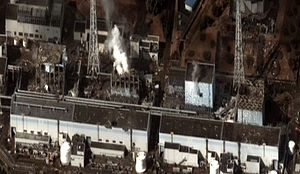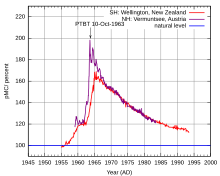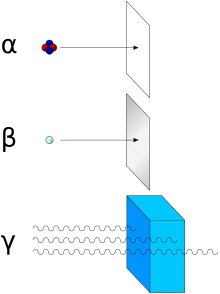In Buddhism, buddhahood (Sanskrit: buddhatva; Pali: buddhatta or buddhabhāva; Chinese: 佛果) is the condition or rank of a buddha "awakened one".
The goal of Mahayana's bodhisattva path is Samyaksambuddhahood, so that one may benefit all sentient beings by teaching them the path of cessation of dukkha. Mahayana theory contrasts this with the goal of the Theravada path, where the goal is individual arhatship.
Explanation of the term Buddha
In Theravada Buddhism, Buddha refers to one who has become awake through their own efforts and insight, without a teacher to point out the dharma (Sanskrit; Pali dhamma; "right way of living"). A samyaksambuddha re-discovered the truths and the path to awakening and teaches these to others after his awakening. A pratyekabuddha also reaches Nirvana through his own efforts, but does not teach the dharma to others. An arhat needs to follow the teaching of a Buddha to attain Nirvana, but can also preach the dharma after attaining Nirvana. In one instance the term buddha is also used in Theravada to refer to all who attain Nirvana, using the term Sāvakabuddha to designate an arhat, someone who depends on the teachings of a Buddha to attain Nirvana. In this broader sense it is equivalent to the arhat.
Buddhahood is the state of an awakened being, who having found the path of cessation of dukkha ("suffering", as created by attachment to desires and distorted perception and thinking) is in the state of "No-more-Learning".
There is a broad spectrum of opinion on the universality and method of attainment of Buddhahood, depending on Gautama Buddha's teachings that a school of Buddhism emphasizes. The level to which this manifestation requires ascetic practices varies from none at all to an absolute requirement, dependent on doctrine. Mahayana Buddhism emphasizes the bodhisattva ideal instead of the Arhat.
The Tathagatagarba and Buddha-nature
doctrines of Mahayana Buddhism consider Buddhahood to be a universal
and innate property of absolute wisdom. This wisdom is revealed in a
person's current lifetime through Buddhist practice, without any
specific relinquishment of pleasures or "earthly desires".
Buddhists do not consider Gautama to have been the only Buddha. The Pāli Canon refers to many previous ones (see list of the named Buddhas), while the Mahayana tradition additionally has many Buddhas of celestial origin (see Amitābha or Vairocana as examples, for lists of many thousands of Buddha names (see Taishō Tripiṭaka numbers 439–448).
Nature of the Buddha
The various Buddhist schools hold some varying interpretations on the nature of Buddha (see below).
Attainments
The Buddha, in Greco-Buddhist style, first-second century, Gandhara (now Pakistan). (Standing Buddha).
All Buddhist traditions hold that a Buddha is fully awakened and has completely purified his mind of the three poisons of craving, aversion and ignorance. A Buddha is no longer bound by saṃsāra, and has ended the suffering which unawakened people experience in life.
Most schools of Buddhism have also held that the Buddha was omniscient. However, the early texts contain explicit repudiations of making this claim of the Buddha.
Ten characteristics of a Buddha
Some
Buddhists meditate on (or contemplate) the Buddha as having ten
characteristics (Ch./Jp. 十號). These characteristics are frequently
mentioned in the Pāli Canon as well as Mahayana teachings, and are
chanted daily in many Buddhist monasteries:
- Thus gone, thus come (Skt: tathāgata)
- Worthy one (Skt: arhat)
- Perfectly self-enlightened (Skt: samyak-saṃbuddha)
- Perfected in knowledge and conduct (Skt: vidyā-caraṇa-saṃpanna )
- Well gone (Skt: sugata)
- Knower of the world (Skt: lokavida)
- Unsurpassed (Skt: anuttara)
- Leader of persons to be tamed (Skt: puruṣa-damya-sārathi)
- Teacher of the gods and humans (Skt: śāsta deva-manuṣyāṇaṃ)
- The Blessed One or fortunate one (Skt: bhagavat)
The tenth epithet is sometimes listed as "The World Honored Enlightened One" (Skt. Buddha-Lokanatha) or "The Blessed Enlightened One" (Skt. Buddha-Bhagavan).
Ten Indispensable Duties of a Buddha
According
to Buddhist texts, upon reaching Buddhahood each Buddha must perform
ten acts during his life to complete his duty as a Buddha.
- A Buddha must predict that another person will attain Buddhahood in the future.
- A Buddha must inspire somebody else to strive for Buddhahood.
- A Buddha must convert all whom he must convert (i.e. his chief disciples, etc.).
- A Buddha must live at least three-quarters of his potential lifespan.
- A Buddha must have clearly defined what are good deeds and what are evil deeds.
- A Buddha must appoint two of his disciples as his chief disciples.
- A Buddha must descend from Tavatimsa Heaven after teaching his mother.
- A Buddha must hold an assembly at Lake Anavatapta.
- A Buddha must bring his parents to the Dhamma.
- A Buddha must have performed the great Miracle at Savatthi.
Buddha as a supreme human
In the Pāli Canon, Gautama Buddha is known as being a "teacher of the
gods and humans", superior to both the gods and humans in the sense of
having nirvana or the greatest bliss, whereas the devas, or gods, are still subject to anger, fear and sorrow.
In the Madhupindika Sutta (MN 18),
Buddha is described in powerful terms as the Lord of the Dhamma (Pali:
Dhammasami, skt.: Dharma Swami) and the bestower of immortality (Pali:
Amatassadata).
Similarly, in the Anuradha Sutta (SN 44.2) Buddha is described as
the Tathagata—the supreme man, the superlative man, attainer of the superlative attainment.
[Buddha is asked about what happens to the Tathagatha after death of the physical body. Buddha replies],
"And so, Anuradha—when you can't pin down the Tathagata as a truth or reality even in the present life—is it proper for you to declare, 'Friends, the Tathagata—the supreme man, the superlative man, attainer of the superlative attainment—being described, is described otherwise than with these four positions: The Tathagata exists after death, does not exist after death, both does & does not exist after death, neither exists nor does not exist after death'?
In the Vakkali Sutta (SN 22.87) Buddha identifies himself with the Dhamma:
O Vakkali, whoever sees the Dhamma, sees me [the Buddha]
Another reference from the Aggañña Sutta of the Digha Nikaya, says to his disciple Vasettha:
O Vasettha! The Word of Dhammakaya is indeed the name of the Tathagata
Shravasti Dhammika, a Theravada monk, writes:
In the centuries after his final Nibbāna it sometimes got to the stage that the legends and myths obscured the very real human being behind them and the Buddha came to be looked upon as a god. Actually, the Buddha was a human being, not a 'mere human being' as is sometimes said but a special class of human called a 'complete person' (mahāparisa). Such complete persons are born no different from others and indeed they physically remain quite ordinary.
Sangharakshita
also states that "The first thing we have to understand - and this is
very important - is that the Buddha is a human being. But a special kind
of human being, in fact the highest kind, so far as we know."
Buddha as a human
When asked whether he was a deva
or a human, he replied that he had eliminated the deep-rooted
unconscious traits that would make him either one, and should instead be
called a Buddha; one who had grown up in the world but had now gone
beyond it, as a lotus grows from the water but blossoms above it,
unsoiled.
Andrew Skilton writes that the Buddha was never historically regarded by Buddhist traditions as being merely human:
It is important to stress that, despite modern Theravada teachings to the contrary (often a sop to skeptical Western pupils), he was never seen as being merely human. For instance, he is often described as having the thirty-two major and eighty minor marks or signs of a mahāpuruṣa, "superman"; the Buddha himself denied that he was either a man or a god; and in the Mahāparinibbāna Sutta he states that he could live for an aeon were he asked to do so.
However, Thích Nhất Hạnh, a Vietnamese Buddhist monk in the Zen tradition, states that "Buddha was not a god. He was a human being like you and me, and he suffered just as we do."
Jack Maguire writes that Buddha is inspirational based on his humanness.
A fundamental part of Buddhism's appeal to billions of people over the past two and a half millennia is the fact that the central figure, commonly referred to by the title "Buddha", was not a god, or a special kind of spiritual being, or even a prophet or an emissary of one. On the contrary, he was a human being like the rest of us who quite simply woke up to full aliveness.
Basing his teachings on the Lotus Sutra, the Chinese monk Chi-hi
(the founder of the Tendai Sect) developed an explanation of life
"three thousand realms in a single moment", which posits a Buddha nature
that can be awakened in any life, and that it is possible for a person to become "enlightened to the Law". In this view, the state of Buddhahood and the states of ordinary people are exist with and within each other.
Nichiren, the founder of Nichiren Buddhism states that the real meaning of the Lord Shakyamuni Buddha’s appearance in this world lay in his behavior as a human being.
He also stated that "Shakyamuni Buddha . . . the Lotus Sutra . . . and
we ordinary human beings are in no way different or separate drom each
other".
Mahāsāṃghika supramundane Buddha
In the early Buddhist schools, the Mahāsāṃghika
branch regarded the buddhas as being characterized primarily by their
supramundane nature. The Mahāsāṃghikas advocated the transcendental and
supramundane nature of the buddhas and bodhisattvas, and the fallibility
of arhats. Of the 48 special theses attributed by the Samayabhedoparacanacakra to the Mahāsāṃghika Ekavyāvahārika, Lokottaravāda, and the Kukkuṭika, 20 points concern the supramundane nature of buddhas and bodhisattvas. According to the Samayabhedoparacanacakra, these four groups held that the Buddha is able to know all dharmas in a single moment of the mind. Yao Zhihua writes:
In their view, the Buddha is equipped with the following supernatural qualities: transcendence (lokottara), lack of defilements, all of his utterances preaching his teaching, expounding all his teachings in a single utterance, all of his sayings being true, his physical body being limitless, his power (prabhāva) being limitless, the length of his life being limitless, never tiring of enlightening sentient beings and awakening pure faith in them, having no sleep or dreams, no pause in answering a question, and always in meditation (samādhi).
A doctrine ascribed to the Mahāsāṃghikas is, "The power of the
tathāgatas is unlimited, and the life of the buddhas is unlimited."
According to Guang Xing, two main aspects of the Buddha can be seen in
Mahāsāṃghika teachings: the true Buddha who is omniscient and
omnipotent, and the manifested forms through which he liberates sentient
beings through skillful means. For the Mahāsaṃghikas, the historical Gautama Buddha was one of these transformation bodies (Skt. nirmāṇakāya), while the essential real Buddha is equated with the Dharmakāya.
As in Mahāyāna traditions, the Mahāsāṃghikas held the doctrine of
the existence of many contemporaneous buddhas throughout the ten
directions. In the Mahāsāṃghika Lokānuvartana Sūtra, it is stated, "The Buddha knows all the dharmas of the countless buddhas of the ten directions." It is also stated, "All buddhas have one body, the body of the Dharma."
The concept of many bodhisattvas simultaneously working toward
buddhahood is also found among the Mahāsāṃghika tradition, and further
evidence of this is given in the Samayabhedoparacanacakra, which describes the doctrines of the Mahāsāṃghikas.
A statue of Gautama Buddha at Tawang Monastery, India.
Depictions of the Buddha in art
Buddhas are frequently represented in the form of statues and paintings. Commonly seen designs include:
- The Seated Buddha
- The Reclining Buddha
- The Standing Buddha
- Hotei or Budai, the obese Laughing Buddha, usually seen in China (This figure is believed to be a representation of a medieval Chinese monk who is associated with Maitreya, the future Buddha, and is therefore technically not a Buddha image.)
- the Emaciated Buddha, which shows Siddhartha Gautama during his extreme ascetic practice of starvation.
The Buddha statue shown calling for rain is a pose common in Laos.
Markings
Most depictions of Buddha contain a certain number of markings, which are considered the signs of his enlightenment. These signs vary regionally, but two are common:
- a protuberance on the top of the head (denoting superb mental acuity)
- long earlobes (denoting superb perception)
In the Pāli Canon, there is frequent mention of a list of thirty-two physical characteristics of the Buddha.
Hand-gestures
The poses and hand-gestures of these statues, known respectively as asanas and mudras,
are significant to their overall meaning. The popularity of any
particular mudra or asana tends to be region-specific, such as the Vajra (or Chi Ken-in) mudra, which is popular in Japan and Korea but rarely seen in India. Others are more common; for example, the Varada (Wish Granting) mudra is common among standing statues of the Buddha, particularly when coupled with the Abhaya (Fearlessness and Protection) mudra.














